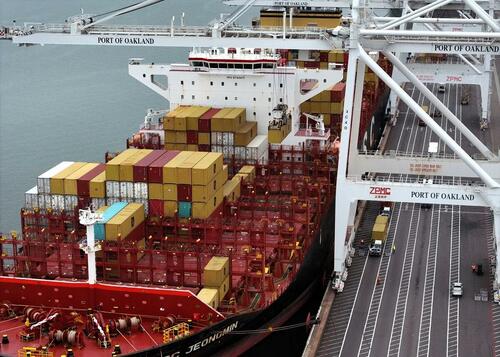
Отсчет до дефицита? Последние грузовые суда из Китая прибыли в порты США
Тарифы США на большинство китайских товаров в настоящее время удерживаются на уровне 145%, но не применяются к товарам, перевозимым грузовыми судами уже в море. Это означает, что многие продукты, по-прежнему проходящие через порты США, не требуют от компаний уплаты дополнительных пошлин. Однако ситуация изменится, поскольку последние суда из Китая, свободные от тарифных сборов, наконец-то прибывают на Западное побережье.
Последствия тарифов уже ударили по Китаю, как кувалда. Многие компании отменили заказы от китайских производителей, и компании реализуют стратегию «жди и смотри» (когда они должны искать альтернативных поставщиков). Некоторые компании ищут портовые хранилища для хранения своих товаров в надежде, что тарифы будут сняты. В конечном счете, это означает, что многие заводы Китая будут закрыты, возможно, в течение нескольких месяцев.
СМИ истеблишмента в США раскручивают это событие как потенциально «хуже, чем covid» с точки зрения надвигающейся нехватки, но так ли это на самом деле? Пустые полки уже в пути?
Сравнение пандемии иронично выдает некую несовершенную логику со стороны журналистов и проглобалистских экономистов. Даже в разгар блокировок цепочка поставок оставалась относительно адаптивной. Трудно поверить, что тарифы могут быть хуже, учитывая, что не все страны-производители сталкиваются с одинаковыми препятствиями.
Китай, в частности, не является неотъемлемой частью цепочки поставок Америки, как это было раньше. С 2018 года импорт США из Китая сократился с 21% от общего объема товаров до 13% от общего объема товаров. Зависимость США от Китая резко снизилась. Только 7% американского экспорта идет в Китай; ничтожная часть общего ВВП.
С другой стороны, у Китая серьезные проблемы. Хотя их экспорт в США упал до 15% от общего объема товаров, коммунистическая нация находится в разгаре сокрушительного дефляционного кризиса. Любые серьезные потрясения в их системе на данном этапе вызовут долгосрочный кризис. Кроме того, нет замены потребительского рынка, чтобы заполнить пустоту, которую США оставляют позади. Только США представляют 30% мирового потребительского рынка. Почти каждый производитель в мире зависит от американских закупок.
Еще более опасна зависимость Китая от американских сельскохозяйственных товаров. Их импорт из США сократился с 29% в 2009 году до 13% в 2024 году, но их поставки продовольствия по-прежнему нестабильны. Опять же, любое потрясение в этой области их экономики может иметь далеко идущие последствия.
Однако есть некоторые риски для США. Например, большой процент безрецептурных препаратов и некоторых антибиотиков в США поступает из Китая (например, около 95% ибупрофена в США поступает из Китая). Около 20% импорта одежды и 24% импорта текстиля приходится на Китай. От 60% до 80% многих потребительских электронных товаров в США производятся в Китае, включая смартфоны, ноутбуки и игровые консоли. Около 80% всех игрушек в США производятся в Китае.
В то время как внебиржевой дефицит лекарств может представлять собой жизнеспособную проблему, многие товары, которые американцы покупают в Китае, менее необходимы.
Более значительные экономические последствия, вероятно, будут заметны в небольших бутиках, которые импортируют материалы для своей продукции. Компании, которые полагаются на Китай за дешевые бутылки, банки, контейнеры, коробки и этикетки и т.д. Малые предприятия пострадают, если они полностью перейдут из Китая, и, вероятно, повысят свои цены, поскольку они ищут альтернативы.
Лазейка из Китая также была закрыта, поэтому международные прямые импортеры, такие как Temu, Shein и Aliexpress, получат удар.

Маловероятно, что тарифы только на Китай окажут существенное влияние на поставки из США. Ряд корпораций уже перемещают свое производство в другие места, а некоторые компании уже перемещают некоторые заводы в США. Тем не менее, внутреннее производство в США определенно не то, что было раньше, и оно не готово заполнить пробелы в цепочке поставок, оставленные крупными странами-экспортерами. Если значительное число стран будут вынуждены закрыть заводы одновременно, дефицит действительно может представлять угрозу.
Внутреннее производство должно стать центральным вопросом для администрации Трампа, которая была сосредоточена на тарифах, но не дала достаточно подробного плана по возвращению «Сделано в США» достаточно быстро, чтобы компенсировать последствия. Американская общественность должна услышать, как именно это будет сделано.
Между тем, гораздо более вероятно, что Китай взорвется под тяжестью тарифов и продолжающегося дефляционного кризиса. Если КПК хочет избежать массовой безработицы и гражданских беспорядков, они будут моргать.
Тайлер Дерден
Свадьба, 05/07/2025 - 10:25
















